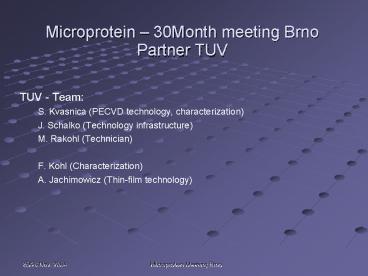Microprotein 30Month meeting Brno Partner TUV - PowerPoint PPT Presentation
1 / 18
Title:
Microprotein 30Month meeting Brno Partner TUV
Description:
S. Kvasnica (PECVD technology, characterization) J. Schalko (Technology infrastructure) ... Capillary pressure prevents spitting. Position substrate ... – PowerPoint PPT presentation
Number of Views:57
Avg rating:3.0/5.0
Title: Microprotein 30Month meeting Brno Partner TUV
1
Microprotein 30Month meeting BrnoPartner TUV
- TUV - Team
- S. Kvasnica (PECVD technology, characterization)
- J. Schalko (Technology infrastructure)
- M. Rakohl (Technician)
- F. Kohl (Characterization)
- A. Jachimowicz (Thin-film technology)
2
Outline
- Introduction
- Experimental results
- Conclusions
- Future Work
3
Electrowetting basics
4
Film properties
- extremely thin insulating films top of metal pads
(V2 ? d) - extremely high dielectric strength (E2 ? 1/d)
- high permittivity (V2 ? 1/?r)
- hydrophobic surface (only enhancement of wetting
is possible) - sustainable actuation demands for
- tight structure (no ion migration/trapping)
- adressable microspotting on an array needs
- reproducible cycling behaviour (stable surfaces)
- potential for miniaturization
5
Electrowetting transport experiments
Technology Silicon, Metal electrodes (Au/Ti) 2
µm Teflon AF (6)
6
User interface for host controlled operation
Zero mean potential of wafer droplet
7
Electrowetting transport Gap size dependence
Sawtooth pattern 40µm pitch, 72 µm height
8
Electrowetting transport Dependence on
excitation voltage
Excitation pattern shifted along the electrode
chain according to the actual droplet movement.
9
Observations
- At low actuation potentials (40V)
- Very slow, creeping motion
- Droplet overcomes only gaps lt18µm
10
Observations
- At 60V actuation potential
- More agile movement
- Speed decreases with gap width
- Up to 28µm gaps passed
- Droplet shape develops a tail
11
Observations
- At 80V actuation potential
- Gaps of 58 µm are easily passed by
- Droplet tail turns out to be caused by a dust
particle - Adsorption of particles is promoted by the
excitation voltage - Adsorbed particles effectively hinder the droplet
transport
12
Conclusions
- High actuation potentials are needed to enable
droplet transport by electrowetting - High actuation potentials promote (dust)
adsorption at the electrodes - Adsorbed particles resemble a severe obstacle for
droplet transport - Any additional solid surface in contact with the
droplet will hinder the droplet transport if not
actuated.
13
Discontinuous surfaces may prevent low actuation
voltages especially within closed arrangements
14
Future work
Possible solutions
- New low surface energy FC coating materials
- Cytop,
- OPTOOL-DSX,
- Fluorothane
- enabling thinner coatings, lower actuation
potentials, .... - Droplet transport
- driven by external pressure difference
- controlled through capillary pressure modulation
- (by the electrowetting effect)
15
Future Work
- Microfluidic fine spotting Adaptation of the
Proposed concept
16
Modified spotting arrangement
Pressure
Electrowetting Actuation
Capillary
-
Biomolecule
Solution
FC Layer
Si-Wafer
Substrate
Passivation
17
Technology concept
- Si-wafer used for EW actuation
- Micromachining of the nozzle cone
- Surface passivation by Oxide/Nitride (HT)
- FC coating on top side by plasma assisted process
- Orifice (spot size) definition by dry etch
(bottom side) - Assembly, electrical connection
18
Operation
- Apply sub-threshold static pressure
- Capillary pressure prevents spitting
- Position substrate
- Switch capillary pressure by application of a
short electrical pulse - Move to the next spot site































